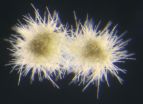(Press-News.org) Over the past few years, extracellular vesicles, or membrane sacs secreted from cells, have emerged as important mediators by which cells communicate with their surroundings to regulate a diverse range of biological processes. In addition, specialized roles for extracellular vesicles are beginning to be recognized in various diseases including cancer, infectious diseases and neurodegenerative disorders. Moreover, engineered extracellular vesicles are likely to have applications in drug delivery.
The laboratory of Crislyn D'Souza-Schorey, Morris Pollard Professor and Chair of the Department of Biological Sciences at the University of Notre Dame, has been investigating a unique population of vesicles released from tumor cells.
"We refer to these vesicles as tumor-derived microvesicles," she said. "Our work over the past few years has focused on their role in enhancing tumor cell invasion. Emerging evidence suggests that extracellular vesicles can propagate cancers in several ways -- for example, by breaking down the extracellular matrix to allow tumor cells to invade their surroundings, by enhancing angiogenesis and by possibly modulating the patient's immune system, all of which promote metastases."
In cancers, the number of tumor-derived microvesicles in circulation increases with disease stage. Not only are they provocative targets for therapeutic intervention, they are also potentially rich reservoirs of clinical biomarkers, D'Souza-Schorey noted. Despite this, there is only a rudimentary understanding of how this specialized subset of membrane vesicles is shed from tumor cells.
"We know that it is not random release from cells, but that tumor cell components are targeted to these vesicles before they are pinched and realized from cells," she said.
In a study published Tuesday (April 21) in Nature Communications, her research group provides insight into how certain proteins may be directed to tumor microvesicles. They show that a protein called VAMP3 guides key components of the cell toward shedding microvesicles to help facilitate extracellular matrix breakdown and tumor invasion.
"Getting at this type of information is important because it provides options for how one might be able to modulate the composition of these shed vesicles or prevent release," James Clancy, the lead author on the study, said.
The study also shows that microvesicles were identified in the blood and ascites of women with ovarian cancer.
"We think that these microvesicles are shed into circulation universally by tumors, and began testing this hypothesis by assessing the body fluids of patients with ovarian cancer," D'Souza-Schorey said.
This was aided in part by collaboration with physician oncologist Michael Method and his team at Michiana Hematology Oncology. The collaboration was initiated several years ago, when the laboratory first identified these microvesicles in their tumor cell cultures.
"We sought to investigate whether this population of microvesicles could also be detected in the body fluids on cancer patients," D'Souza-Schorey said. "Dr. Method not only provided oversight of the clinical samples we obtained, but he also walked us through the pathophysiology of the cases we were investigating."
The study shows that CA-125, a commonly used serum biomarker for ovarian cancer, is highly enriched in microvesicles isolated from ovarian patients. These findings suggest that the development of microvesicle-based biomarkers has the potential to enrich key tumor markers and enhance the sensitivity of detection. These results are particularly timely as there is growing interest in harnessing circulating microvesicles as disease biomarkers.
INFORMATION:
The study was supported in part by a grant from the National Cancer Institute and the Advanced Diagnostics and Therapeutics Strategic Research Initiative at the University of Notre Dame.
Beverages sweetened with low, medium and high amounts of high-fructose corn syrup significantly increase risk factors for cardiovascular disease, even when consumed for just two weeks by young, healthy men and women, reports a team of researchers at the University of California, Davis.
The study is the first to demonstrate a direct, dose-dependent relationship between the amount of added sugar consumed in sweetened beverages and increases in specific risk factors for cardiovascular disease.
The data reinforce evidence from an earlier epidemiological study showing that ...
COLUMBIA, Mo. -Due to the ever-increasing number of people using social media sites such as Facebook and Twitter, businesses and organizations, such as professional sports teams, are expanding their marketing and communication efforts to engage people with their brands through those sites. Now, Nicholas Watanabe, an assistant teaching professor at the University of Missouri, along with colleagues from MU and Louisiana State University, analyzed Major League Baseball (MLB) teams' use of Twitter to engage and increase fan interest. They found that the more individual teams ...
LEXINGTON, KY. (Apr. 22, 2015) -- It was once thought that effects of a mild head injury -- dizziness, headaches, memory problems -- were only temporary, and the brain would heal over time. However, while the long-term consequences of head trauma are not fully known, growing evidence suggests that even a mild head injury can increase the risk for later-in-life development of dementias such as Alzheimer's disease.
Researchers at the University of Kentucky's Sanders-Brown Center on Aging have been attempting to understand the cascade of events following mild head injury ...
From AGU's blogs: Volcanic soundscapes reveal differences in undersea eruptions
New research matching different types of underwater volcanic eruptions with their unique sound signatures could help scientists better detect and understand emissions occurring on the seafloor.
From Eos.org: Is the Shale Boom Reversing Progress in Curbing Ozone Pollution?
Concentrations of volatile organic compounds--precursors to ground-level ozone formation--are on the rise in areas over and downwind of a major shale oil and gas field in Texas.
From AGU's journals: When the Sun ...
How aware are you of the birds that live in your neighborhood? Do you know how many different species there are? Do enjoy your local birds, or find them annoying? J. Amy Belaire of St. Edward's University, Lynne Westphal of the U.S. Forest Service, and Emily Minor and Christopher Whelan of the University of Illinois at Chicago visited urban neighborhoods in the Chicago area to answer these questions and learn more about how people see their backyard birds. Their results, published in a new paper in The Condor: Ornithological Applications, provide a fascinating look at the ...
Life as a wild baby bird can involve a lot of stress; competing with your siblings, dealing with extreme weather, and going hungry due to habitat loss are just a few examples. However, birds have an amazing capacity to overcome stresses experienced early in life and go on to reproductive success as adults, according to a new Perspective paper in The Auk: Ornithological Advances by Hugh Drummond and Sergio Ancona of the Universidad Nacional Autónoma de México.
Some experiments with birds in captivity have found that increasing early-life stress through food deprivation, ...
TEMPE, Ariz. - As the search continues for Earth-size planets orbiting at just the right distance from their star, a region termed the habitable zone, the number of potentially life-supporting planets grows. In two decades we have progressed from having no extrasolar planets to having too many to search. Narrowing the list of hopefuls requires looking at extrasolar planets in a new way. Applying a nuanced approach that couples astronomy and geophysics, Arizona State University researchers report that from that long list we can cross off cosmic neighbor Tau Ceti.
The ...
Scientists have found something they can't quite explain in one of the most barren environments on Earth: a bacterium whose DNA sequence contains elements usually only found in a much higher organism.
Trichodesmium is a type of bacteria known as an oligotroph, meaning that it can survive in incredibly nutrient-poor regions of the ocean. In fact, it thrives there -- to the point that great blooms of the microorganism can be seen both with the naked eye and from satellites in space, earning it the name "sea sawdust" from ancient mariners.
This is because Trichodesmium ...
A new type of graphene aerogel will make for better energy storage, sensors, nanoelectronics, catalysis and separations.
Lawrence Livermore National Laboratory researchers have made graphene aerogel microlattices with an engineered architecture via a 3D printing technique known as direct ink writing. The research appears in the April 22 edition of the journal, Nature Communications.
The 3D printed graphene aerogels have high surface area, excellent electrical conductivity, are lightweight, have mechanical stiffness and exhibit supercompressibility (up to 90 percent ...
Montréal, April 22, 2015 - Researchers at the IRCM led by Artur Kania, PhD, uncovered the critical role in pain processing of a gene associated with a rare disease. Their breakthrough, published in The Journal of Neuroscience, paves the way for a better understanding of chronic pain conditions.
Dr. Kania's team studies the way neural circuits transform harmful stimuli (such as cold, heat, and pinch) into the perception of pain. More precisely, they examined the gene Lmx1b and its involvement in pain processing. Mutations in this gene also cause a rare human disease ...



